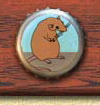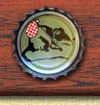Dutch Treat: A Taste of the Low Lands
First published in WanderRat issue V2N1 (January 1995)

There were once over 10,000 windmills grinding grain and pumping water out of the swamp lands on the northwest corner of Europe. The Netherlands is populated by no more than 1000 windmills today, but over 220 different beers. The Vermin Brewing Research Team travelled to the Netherlands to get a taste of what the Dutch offer aside from cheese.
SURPRISING VARIETY
Our first surprise was when we walked into Albert Heijn, a medium size chain supermarket in the small town of Borculo about 40 km from the German border. Dozens of different beers greeted us. Several styles from standard pils to exotic lambic ales, from major Dutch brewery concerns like Heineken to small Trappist monasteries in Belgium. No one seemed too surprised as the research team brought several heavily laden sacks to the check stand, perhaps hinting that enjoying the wide variety of beers is nothing new for the locals.
IT WASN’T ALWAYS LIKE THIS
During interviews with the local citizens, we were continually surprised to discover that many had no idea what kinds of beer were available. Most everyone enjoyed a pils now and then and many even have a favorite brewery, but they were themselves astonished at the variety that even the local grocery store had to offer. Understandably so. The Netherlands once had as many as 2000 breweries. For several reasons including competition, lack of basic ingredients, and most of all world war, the beer quality dropped, consumption decreased and breweries disappeared. By 1980 each of the 13 remaining Dutch breweries offered primarily pils. Some, but not all, brewed a Dortmunder (stronger, less bitter pils named after its origin, Dortmund, Germany), Oud Bruin (old brown, dark mild beer, low in alcohol and often sweetened with added sugar), and dark Bokbier (German style bock). The turning point came only recently in 1981 when Arcense Bierbrouwerij was founded. Diverse beer types were brought back to life and sold as special beers. The success of Arcense led to the founding of over 20 breweries, most found in the southern provinces of Limburg and Noord Brabant. Holland is, by the way, only a province in the northwest in which the city of Amsterdam is located. The past ten years have witnessed a virtual renaissance of Dutch beer.
FROM PILS TO BARLEY WINE
Dutch beers are influenced by styles from each of the Netherland’s neighbors. One can find Belgian style wit beers, blonds, ambers, and Trappist ales; German type pils, alts, wheats and bocks; and English sorts such as ales, stouts, and barley wine. Oud Bruin is the only indigenous beer, brewed almost exclusively in the Netherlands. The VB Research Team found Oud Bruin too sweet for their tastes, but excellent in local recipes like Appelflaps.
REINHEITSGEBOT, SHMEINHEITSGEBOT: DUTCH LIBERALNESS
Variety in styles also applies for variety of ingredients. The Dutch have little sympathy for the strict German adherence to the beer purity law. Many beers have adjuncts such as caramel or rice, but not simply due to modern streamlined production techniques. Some breweries are quite proud of their recipes including corn or other selected grains and proudly list the ingredients on the label. Furthermore, many beers are deliciously flavored with a wide variety of fruits from peaches to black currants.
WACKY LABELS
 The VB Research team is still hard at work sampling the 100 or so different beers bought in the Netherlands. Before we even began to taste however, we couldn’t help but noticing the playful labels. Luckily travelling during the holiday season gave us the opportunity to find several special beers brewed only for a short time, such as Witte Kerst (White Christmas) or Heineken 1995 (a New Year’s beer). We especially flick our tails to Gulpener Bierbrouwerij for their Korenwolf (grain wolf) beer. A Korenwolf is the local name for a hamster and this tasty Wit beer features a picture of the industrious rodent who diligently hunts down as much of the, so vital to beer brewing, grain as possible to hamster, or hoard, it away for his own purpose. Perhaps rats are not alone in their devotion to the noble art of brewing!
The VB Research team is still hard at work sampling the 100 or so different beers bought in the Netherlands. Before we even began to taste however, we couldn’t help but noticing the playful labels. Luckily travelling during the holiday season gave us the opportunity to find several special beers brewed only for a short time, such as Witte Kerst (White Christmas) or Heineken 1995 (a New Year’s beer). We especially flick our tails to Gulpener Bierbrouwerij for their Korenwolf (grain wolf) beer. A Korenwolf is the local name for a hamster and this tasty Wit beer features a picture of the industrious rodent who diligently hunts down as much of the, so vital to beer brewing, grain as possible to hamster, or hoard, it away for his own purpose. Perhaps rats are not alone in their devotion to the noble art of brewing!










